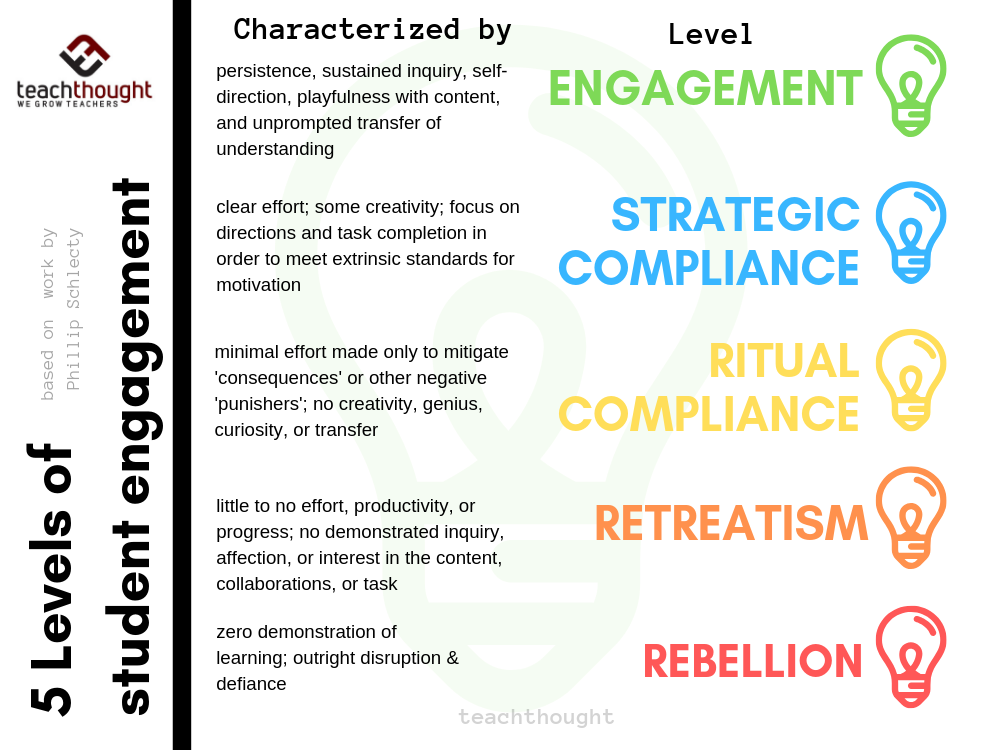
What Are The 5 Levels Of Student Engagement?
by Terry Heick
Years ago, I worked with a school in Kentucky that had adopted Phil Shlechty’s “Working on the Work” framework.
The idea behind Shlechty’s framework is, in short, to focus on the work that students do, and the systems that produce that work. While there are critics of how it works in practice, the ideas are sound. One of the stickier takeaways for me from the “WoW” resources was the idea of levels of student engagement. I had recognized every level in my classroom as a teacher (struggling students usually in the ‘Retreatism’ area, while even the ‘best’ students I had seemed to be around the ‘Ritual Compliance’ level. It was eye-opening for me.
For starters, the idea of ‘authentic engagement’ now had a new standard. No longer was ‘paying attention’ and eye contact and completing the assignments the standard. I started looking for sustained immersion.
I also began to itemize the kinds of things that motivated students. It was already clear to me that students want to ‘do well in school’ for different reasons, but now those ‘reasons’ had names and I could see a full continuum of student engagement in my mind. This helped me begin to plan (creating tiered learning targets, for example) not just for ‘mastery level’ but the engagement of minds that would then lead to that kind of mastery I’d been looking for.
I’ve had this post drafted for years now because I’d planned on fleshing it out a bit with some thinking about the movement along this kind of continuum but have decided to break that process up and start first with simply sharing the continuum and types of student engagement. I have added some indicators for each level–and note, these are my words while the levels themselves ‘belong to’ Shlechty. He may or may not agree with the indicators–nor did I have much room on the graphic to go into much detail. (I will in a follow-up post).
Please respond in the comments with your thinking, questions, ideas, thoughts.
5 Levels Of Student Engagement: A Continuum For Teaching
Authentic Engagement [Highest Level]
Students are immersed in work that has clear meaning and immediate value to them (reading a book on a topic of personal interest).
Characterized by: persistence, sustained inquiry, self-direction, playfulness with content, and unprompted transfer of understanding
Ritual Compliance
The work has little or no immediate meaning to students, but there are extrinsic outcomes of value that keep them engaged (earning grades necessary for college acceptance).
Characterized by: clear effort; some creativity; focus on directions and task completion in order to meet extrinsic standards for motivation
Passive Compliance
Students see little or no meaning in the assigned work but expend effort merely to avoid negative consequences (not having to stay in during recess to complete work).
Characterized by: minimal effort made only to mitigate ‘consequences’ or other negative ‘punishers’; no creativity, genius, curiosity, or transfer of understanding
Retreatism
Students are disengaged from assigned work and make no attempt to comply but are not disruptive to the learning of others.
Characterized by: little to no effort, productivity, or progress; no demonstrated inquiry, affection, or interest in the content, collaborations, or task
Rebellion [Lowest Level]
Students refuse to do the assigned task, act disruptive, and attempt to substitute alternative activities.
Characterized by: zero demonstration of learning; outright disruption & defiance
5 Levels Of Student Engagement: A Continuum For Teaching